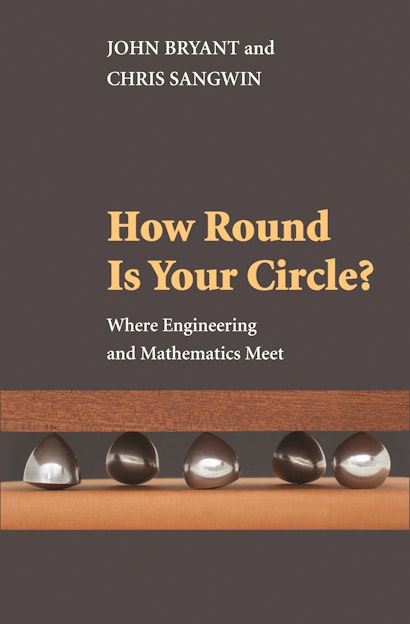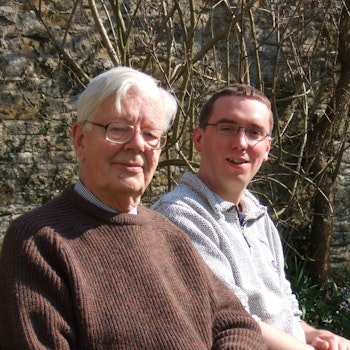How do you draw a straight line? How do you determine if a circle is really round? These may sound like simple or even trivial mathematical problems, but to an engineer the answers can mean the difference between success and failure. How Round Is Your Circle? invites readers to explore many of the same fundamental questions that working engineers deal with every day—it’s challenging, hands-on, and fun.
John Bryant and Chris Sangwin illustrate how physical models are created from abstract mathematical ones. Using elementary geometry and trigonometry, they guide readers through paper-and-pencil reconstructions of mathematical problems and show them how to construct actual physical models themselves—directions included. It’s an effective and entertaining way to explain how applied mathematics and engineering work together to solve problems, everything from keeping a piston aligned in its cylinder to ensuring that automotive driveshafts rotate smoothly. Intriguingly, checking the roundness of a manufactured object is trickier than one might think. When does the width of a saw blade affect an engineer’s calculations—or, for that matter, the width of a physical line? When does a measurement need to be exact and when will an approximation suffice? Bryant and Sangwin tackle questions like these and enliven their discussions with many fascinating highlights from engineering history. Generously illustrated, How Round Is Your Circle? reveals some of the hidden complexities in everyday things.
"There are many books that include ideas or instructions for making mathematical models. What is special about this one is the emphasis on the relation of model- or tool-building with the physical world. The authors have devoted themselves to making wood or metal models of most of the constructions presented; 33 color plates nicely show off their success in this area."—Stan Wagon, American Scientist
"The question posed by this book turns out to be a real toughie, but nevertheless the authors urge you to answer it. This gem of a book tackles several such questions, revealing why they are crucial to engineering and to our understanding of our everyday world. With a nice emphasis on practical experiments, the authors do a refreshing job of bringing out the mathematics you learned in school but sadly never knew why. And they show just how intuitive it can be."—Matthew Killeya, New Scientist
"Mathematics teachers and Sudoku addicts will simply be unable to put the book down. . . . Part magic show, part history lesson, and all about geometry, How Round Is Your Circle? is an eloquent testimonial to the authors' passion for numbers. Perhaps it will spark a similar interest in some young numerophile-to-be."—Civil Engineering
"This is a great book for engineers and mathematicians, as well as the interested lay person. Although some of the theoretical mathematics may not be familiar, you can skip it without losing the point. For school teachers and lecturers seeking to inspire, this is a fantastic resource."—Owen Smith, Plus Magazine
"This book is very clearly written and beautifully illustrated, with line drawings and a collection of photographs of practical models. I can strongly recommend it to anyone with a bit of math knowledge and an interest in engineering problems—a terrific book."—Norman Billingham, Journal of the Society of Model and Experimental Engineers
"This book has many gems and rainbows. . . . The book will appeal to all recreational mathematicians . . . not just because of the way it is written, but also because of the way puzzles, plane dissections and packing and the odd paper folding or origami task are used to bring a point home. . . . More than one copy of this book should be in every school library. . . . It should help to inspire a new generation into mathematics or engineering as well as be accessible to the general reader to show how much mathematics has made the modern world."—John Sharp, LMS Newsletter
"This book can be dense, but it is great for dipping into, a rich resource of interesting thinking and project ideas. Bryant and Sangwin, the engineer and the mathematician, must have had a great time putting this book together. Their enthusiasm and humor shine through."—Tim Erickson, Mathematics Teacher
"The book is very nicely printed and contains many nice figures and photographs of physical models, as well as an extensive bibliography. It can be recommended as a formal or recreational lecture both for mathematicians and engineers."—EMS Newsletter
"This book is a mine of exploration and information. I would recommend it to anyone with an interest in how things work and in how mathematics can help make sense of the world. Budding engineers and mathematicians will find it an inspiration."—John Mason, The Open University
"Truly impressive. This book builds a bridge across the ordinarily huge chasm separating how engineers and mathematicians view the world. Its innovative approach will be refreshing to readers with an engineering bent, and an eye-opener for many mathematicians. The audience for this book includes just about anyone who has any curiosity at all about how mathematics helps in explaining the world."—Paul J. Nahin, author of An Imaginary Tale
"I learned a lot from this book. I think it will have wide appeal, including with those readers who are interested in mathematics and those who are interested in building models. I was up until midnight the other night making a hatchet planimeter out of a coat hanger and washers!"—David Richeson, Dickinson College


